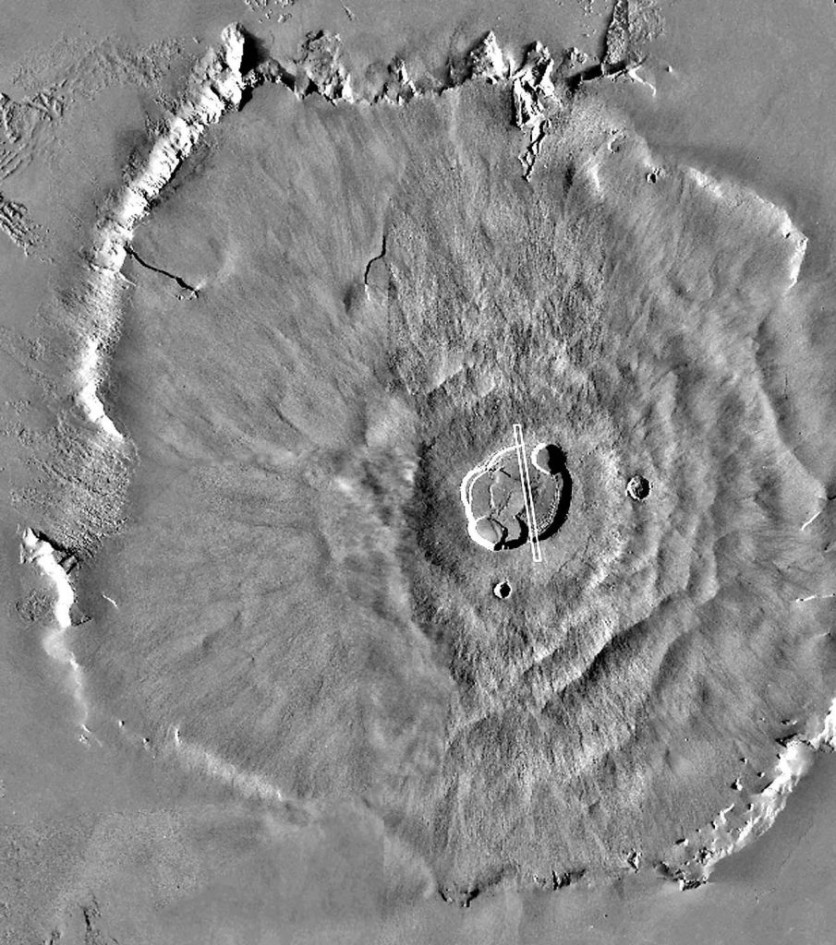Olympus Mons, the highest known peak in the solar system, dominates the Martian landscape, adding to the planet's mystique. Recent geological data reveals that it had a fascinating history as a volcanic island encircled by a huge ocean.

(Photo: NASA/AFP via Getty Images)
This image taken by the Jet Propulsion Laboratory Internet site on 25 April 2000, shows a view taken by imaging equipment on board the Mars Global Surveyor Spacecraft of Olympus Mons, one of the largest volcanoes known on Mars. It is roughly the height of 3 Mount Everest and is nearly 550 km (340 miles) across
Highest Peak in the Solar System
A volcanic caldera may be found near the top of Olympus Mons, a 16-mile-tall Martian volcano with a 374-mile-wide base. It has drawn the attention of scientists for many years and is situated close to the Tharsis Bulge.
Arsia, Pavonis, and Ascraeus Mons are shield volcanoes that are around the active volcano.
According to Anthony Hildenbrand's research at Université Paris-Saclay, Olympus Mons has interesting geological characteristics that are similar to those of volcanic islands like the Azores, Canary Islands, and Hawaiian islands.
Volcanic Formation Studies
It is thought that Olympus Mons, which stands approximately 4 miles (6 km) tall, arose from the depths of the ocean between 3.7 and 3.4 billion years ago.
According to Hildenbrand's team, these escarpments were created when lava flows from the volcano came into contact with the deep ocean.
According to the researchers' findings, Olympus Mons' surrounding depression was previously filled with ocean waters, and the escarpments served as an old coastline.
Similar characteristics have been discovered on the northern slope of Alba Mons, another Martian volcano, suggesting that the depression was produced by the mountain's sheer mass. This illustrates the immense distances that the ancient ocean covered in its grandeur.
Hot areas in the molten mantle, where convection allows heated magma to ascend in enormous plumes, give rise to giant Martian volcanoes.
Hildenbrand hypothesizes the existence of discrete regional plumes beneath Olympus Mons and Alba Mons, which are apart from one another by hundreds of kilometers.
The Tharsis Bulge, a volcanic plateau created by the uplift of plumes, had an impact on the ocean by altering the crust and moving its position.
Previous Speculations
There are two separate shorelines in the Vastitas Borealis lowland area of Mars. A single, persistent ocean is the other hypothesis put out by Hildenbrand's team.
Mars' surface underwent severe deformation as a result of mantle uplift pushing against the planet's crust, revealing two shorelines that were separated in age and giving rise to the Tharsis Bulge.
According to Hildebrand's study, the youngest shorelines in earlier studies could represent the latter phases of a single ocean that was being pushed to the west by a surface uplift in the Tharsis region.
This offers critical insights into Mars' watery past and raises the possibility that the shifting shoreline foreshadowed the end of Mars' habitability.
As technology develops and missions investigate Mars, research into the planet's geological and climatic past reveals riddles and points to potential new findings.
Related Article : Volcano On Mars Continuously Erupted For Two Billion Years

![Apple Watch Series 10 [GPS 42mm]](https://d.techtimes.com/en/full/453899/apple-watch-series-10-gps-42mm.jpg?w=184&h=103&f=9fb3c2ea2db928c663d1d2eadbcb3e52)



